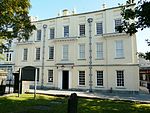Llanelli
Communities in CarmarthenshireLlanelliPages including recorded pronunciationsPages with Welsh IPAPopulated coastal places in Wales ... and 3 more
Ports and harbours of WalesTowns in CarmarthenshireUse British English from January 2021

Llanelli ("St Elli's Parish"; Welsh: [ɬaˈnɛɬi] ) is a market town and community in Carmarthenshire and the preserved county of Dyfed, Wales. It is located on the Loughor estuary and is the largest town in the county of Carmarthenshire.The town is 11 miles (18 km) north-west of Swansea and 12 miles (19 km) south-east of Carmarthen. The town had a population of 25,168 in 2011, estimated in 2019 at 26,225. The local authority was Llanelli Borough Council when the county of Dyfed existed, but it has been under Carmarthenshire County Council since 1996.
Excerpt from the Wikipedia article Llanelli (License: CC BY-SA 3.0, Authors, Images).Llanelli
Hall Street,
Geographical coordinates (GPS) Address Nearby Places Show on map
Geographical coordinates (GPS)
| Latitude | Longitude |
|---|---|
| N 51.684 ° | E -4.163 ° |
Address
Hall Street
Hall Street
SA15 3BB , Mount Pleasant
Wales, United Kingdom
Open on Google Maps









